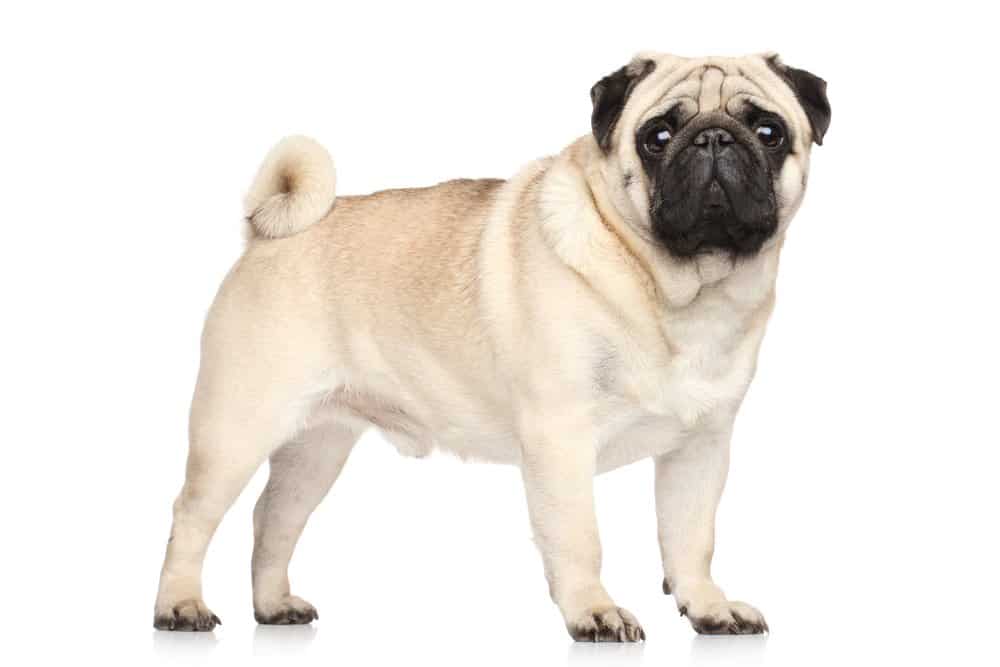If you’ve been thinking of getting a Pug as your next dog, then you’ve probably asked yourself the all-important question:
Do Pugs shed?
Pugs shed twice as much because they have a double coat. Pugs shed all year round, but this is much heavier during spring and fall. Adult Pugs shed more than puppies, and they usually reach full shedding rates by 18 months.
More explanations about this “double coat” in a bit…
Although Pugs shed plenty, this isn’t too different from other breeds.
I’ve owned a Pug or pug mix like the Retro pug for the last five years, so I felt it would be helpful to share my experience with others who are thinking of choosing the breed.
There are plenty of things you can do to manage a pug’s shedding problem.
I’ll discuss these, along with the reasons why Pugs shed so much, in the rest of this article.
Why Do Pugs Shed So Bad?

Regarding Pug shedding level, you’re looking at one of the worst offenders in the dog world.
However, this shouldn’t put you off choosing the breed as your next pet because there are plenty more reasons why you should adopt a Pug than you shouldn’t.
That said, one of the biggest things I wish I’d been aware of before adopting my Pug was how much they shed.
If you haven’t owned a heavy-shedding breed before, it might be not easy to understand how heavy we’re talking.
Just picture stroking your dog and coming away with near handfuls of their fur. While it might not be this bad all year round, it certainly gets that way during some seasons.
Before long, if you’re a bit lazy with the vacuuming, you’ll have enough to build a second dog!
Like all other heavily shedding breeds, there are plenty of reasons why Pugs shed so badly.
If you’re considering adopting a Pug, it can be helpful to understand why Pugs shed so heavily.
More than anything, this can help you notice changes that might signal illness.
How Much Do Pugs Shed Video
Reasons Why Pugs Shed So Much

- Type of coat
Pugs have what’s known as a double-layered coat, which is exactly what it sounds like.
Underneath is a dense undercoat, which is usually soft and fluffy, and on top is a wirier topcoat that often has black hairs running through it, mainly down their back.
The undercoat is generally much softer and fluffier and is thickest around the Pug’s neck and shoulders.
It serves a variety of purposes, most notably as insulation. A Pug’s undercoat is excellent at both keeping heat in and keeping it out, as it serves as a dense layer to protect against hot air.
A Pug’s topcoat contains guard hairs, which protect the dog’s skin from harmful UV rays.
Whereas we have up to 20 layers of skin, Pugs only have around 10, so can get sunburned much more quickly.
While the undercoat offers protection from heat, the topcoat helps to protect against dirt and water.
This isn’t to say a Pug’s coat is waterproof, unlike some other breeds, but it does help small amounts of water wick on the surface and runoff.
You might sometimes find that a Pug’s topcoat feels a bit greasy, but this is entirely normal.
When it comes to shedding, a Pug’s undercoat sheds more than its topcoat. However, this does still shed too.
The reason the undercoat sheds more is that this is what needs to change thickness depending on the season. The top coat, on the other hand, stays the same thickness throughout the year.
- Seasonal changes
As mentioned above, Pug’s undercoat changes depending on the seasons. This help regulates their temperature more efficiently throughout the year.
I’m sure you’ve probably guessed that the undercoat is thicker in the winter and thinner in the summer.
However, Pugs still experience a “coat blow” in both the fall and the spring. This is because they can’t grow more hair alongside their thin summer undercoat.
Instead, they need to completely replace the undercoat with a thicker, denser layer.
A Pug’s seasonal coat blow means much more grooming for you and more house cleaning.
You’re probably looking at a Pug’s coat blow lasting 3-4 weeks, and this will usually happen late in fall and spring.
- Growth rate
All dogs have a standard growth cycle for their coats with three stages. These are growth, rest, and shed.
The technical names for these stages are the anagen phase, the transient catagen phase, and the telogen phase. During the active growth stage, hairs reach their full length and color.
While all dogs follow this cycle, it’s much quicker in Pugs.
There might be various reasons for this, but it’s likely just a genetic “hiccup” from the days before selective breeding was so controlled and scientific.
Either way, it means that Pugs grow and shed their hair much more quickly than other breeds.
- Thickness of coat
The typical thickness of a dog’s coat is between 100 and 200 hairs per square inch. You’d expect this coat thickness on a breed like a Yorkshire Terrier, which should give you some idea of how thick this is.
Pugs, however, have a much thicker coat. This isn’t even a side effect of it being double-layered but is likely to do with people in the past simply wanting fluffier lap dogs.
Pugs have a coating density of around 600 hairs per square inch. This means their coat is about three times thicker than a standard single-layer coat.
In short, all this extra hair leads to more shedding. After all, a dog with three times the hair will shed three times as much.
This probably isn’t too far off the truth, as I’ve owned plenty of other breeds and can say Pugs are one of the heaviest shedders.
Related Questions:
Why do black Pugs shed less?
They shed much less than fawn Pugs because black Pugs only have a single-layered coat rather than a double layer.
Have you seen an extremely rare Brindle Pugs?
Do you think they shed less than fawn pugs as well?
Factors That Can Affect Pug’s Shedding:
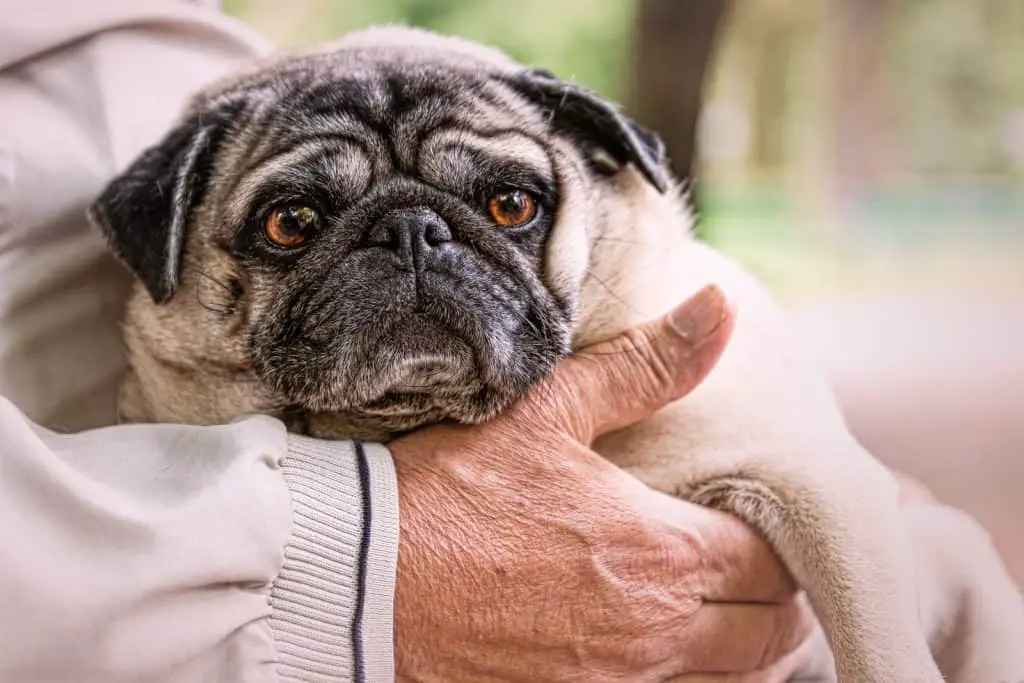
Your Pug may have more frequent changes in their shedding levels than during fall and spring.
You might have thought, “help, my Pug is shedding like crazy!” Then it’s only become worse!
Plenty of factors can affect your Pug’s level of shedding, and it’s worth knowing these so that you can keep an eye out for potential illness or other problems.
Below are the main things that can affect how heavily a Pug sheds.
- Age
Like all other dogs, older Pugs shed more than younger ones. The main reason for this is that a Pug’s puppy coat is much thinner and softer and is only a single layer.
It’s only when they get their full adult coat that their proper shedding level becomes apparent.
So, when do Pugs start shedding?
A Pug usually starts losing its puppy coat around 6 months, but this doesn’t necessarily mean its adult coat is coming through.
You might find that their puppy coat will start thinning in preparation for their adult coat coming through.
A Pug will have its full adult coat by 12-18 months, which can depend on some things but is nothing to worry about.
However, you should find that shedding is minimal for the first few weeks because the coat will be brand new, so all of it will have to go through the same growth, rest, and shed cycle.
- Bathing
Bathing can have a significant impact on your Pug’s shedding level. This is because the massaging action of shampooing stimulates the coat and loosens dead hairs.
While this can help control shedding, it can also help to stimulate new growth.
However, this isn’t necessarily bad if you only bathe your Pug tactically.
Essentially, this means only bathing them around their seasonal changes because if you can time it right, then you should be able to stimulate their coat blow.
This can then be groomed out over a few days, and you’ve avoided the worst of it.
- Hormonal changes
Female Pugs enter their heat cycle every 5-8 months, lasting 2-3 weeks. It’s during this time that their shedding becomes worst, and this is because of the hormonal changes.
A female Pug’s shedding is heaviest during the last phase of her heat cycle or just after giving birth.
How Do I Minimize My Pug From Shedding?
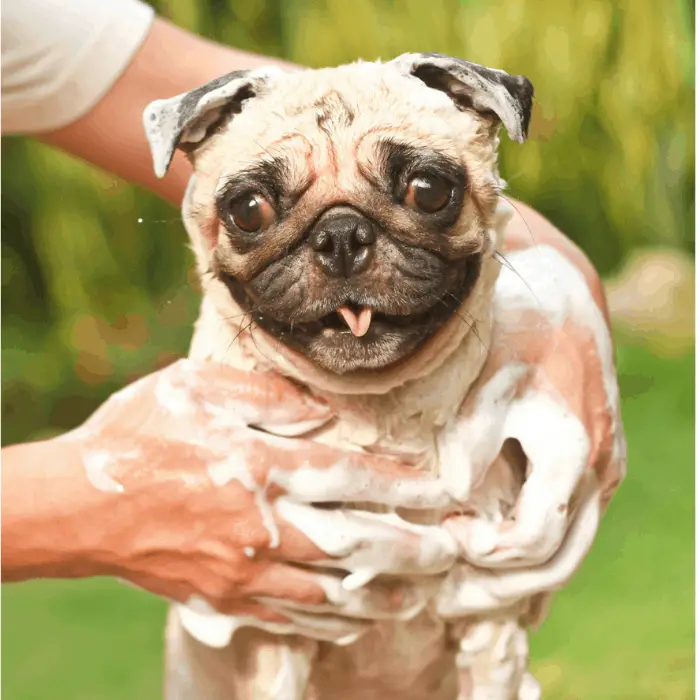
Although there’s no way to completely stop your Pug from shedding (trust me, I’ve looked), there are ways to manage the issue.
The best advice I can give is to try a few of these, as you might find that some are more effective than others.
- Regular grooming
The best thing you can do to control shedding levels is to groom your Pug regularly (I discuss the best tools for this below).
But how often is it regular? This will depend on your dog but can be daily to weekly.
I generally groom my Pug once every three days or so. This seems to keep the worst of the shedding at bay, but then I tend to increase this during seasonal changes.
However, try to avoid daily grooming on a long-term basis, as this can irritate their skin and lead to hair loss.
- Vacuum regularly
Honestly, one of the best things you can do to minimize the amount of Pug hair in the house is clean it up.
If you want your house to be spotless, accept that you’ll be vacuuming daily.
I clean up the dog hair once or twice a week, but then I always make sure to have a deep clean once every two weeks.
Even with weekly cleaning, you’ll find clumps of Pug hair behind furniture, and you’ll regularly see it in places you wouldn’t expect (such as your dinner).
- Find the right diet
A Pug with a poor-quality coat is always going to shed more than one that’s on a proper diet.
What brand or style of food you choose to feed your Pug is entirely up to you, but make sure it’s a good one.
You might wonder:
On top of this, you should invest in Omega-3 or fish oil, as this is amazing for their coat, and you will get it in the best quality. Alternatively, you can use Flax Seed oil, which has the same effect.
- Make sure they’re hydrated
I can’t stress this enough but Pugs need plenty of water. Not only does this help control their temperature, but it also keeps their skin hydrated.
This, in turn, means that hair follicles are stronger, and hair is generally healthier. A hydrated Pug will shed less.
- Choose your grooming spot wisely
Another helpful solution is to groom your Pug outside. Doing this, and then cleaning up after, is one of the best ways to control how much hair ends up in the house.
Realistically, choosing the right grooming spot is one of the best options for Pug hair fall treatment.
Make sure to brush yourself down afterward, as Pug hair is great at getting stuck in clothes.
Birds might appreciate the loose hair for their nests, so leave it somewhere high and out of the way for them.
This is doubly helpful because if your Pug is anything like mine, they’ll enjoy eating clumps of their fur!
Grooming Tools You Need During Pug’s Shedding:
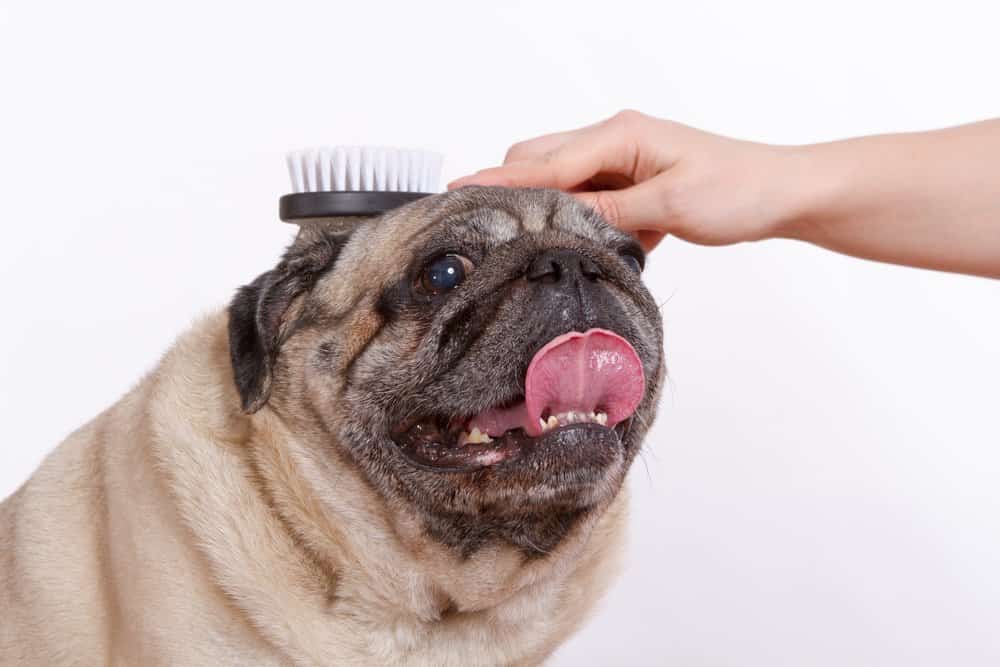
Considering you will be doing plenty of grooming over your Pug’s lifetime, finding the best tools for the job can be helpful.
Here are my top tools for Pug grooming, and using more than one can make their coat look super healthy.
- de-shedding brush
A normal brush won’t cut it for a Pug because you need to reach the thick undercoat. After all, this is where most of the shedding happens. This means you need a specialist tool for the job.
A de-shedding brush is an excellent tool because it has a very fine metal comb, sometimes fitted with a small razor. This helps to trap and thin the shedding hair, making it a handy tool.
I’d recommend a de-shedding tool over almost any other option simply because it’s specifically designed for this job. Most are made from stainless steel, so they are pretty durable too.
- Grooming mitt
A grooming mitt is usually made of rubber and is covered in small tips. If the whole glove isn’t made of rubber, then you’ll still have rubber tips on the inside of the hand.
These small rubber tips are surprisingly effective at pulling loose hairs from the undercoat. However, I’d recommend combining a grooming mitt with a de-shedding brush, as this tool is much better at finishing the coat, leaving it nice and smooth.
What’s more, a grooming glove will probably be the most appealing option for your dog. You’ll probably find this one the easiest to use on them, and you can give them a massage simultaneously.
- fine bristle brush
While a fine-bristled brush won’t be very effective at stripping the dense undercoat, it’ll certainly help the topcoat to look much smoother and shinier. It’ll also help eliminate any debris lodged in your Pug’s coat.
Brushing Tips
- Brush your Pug for around 10-15 minutes per session. Don’t expect to get all the loose hair out, but this should control most of it. Spending too long grooming can irritate their skin.
- You shouldn’t need to brush a Pug’s head and should avoid their eyes at all costs. Concentrate on the areas where the hair is thickest, such as the neck, chest, sides, and back legs.
- All grooming should follow the direction of the fur. Brushing “against the grain” is very uncomfortable for the dog and can be very stressful for them.
- You’ll probably find your Pug isn’t too sure about grooming. Start with short sessions and always reward with plenty of praise. Just increase grooming time gradually, and they should get used to it fine.
- When bathing, only ever use a good quality, hydrating shampoo. Follow the bath with a towel drying and then a good brush.
Is It OK To Shave Pugs?

When the summer heat starts bearing down, and the time is ripe to shave your Pug, the only thing you’ll need to figure out next is- should you?
Whether or not it’s a good idea is up for debate between handlers, groomers, owners, and vets. There are good points on either side of the argument, and opposing sides of the issue have thus far been equally matched.
So, should you shave your Pug?
Never shave (or even trim) your Pug’s coat. Shaving a Pug will remove its undercoat, which, as I mentioned at the start of the article, is vital for maintaining its temperature.
What’s more, you’ll be shaving off the valuable guard hairs that help to prevent sunburn.
While shaving or trimming your Pug’s fur might seem tempting to manage the shedding problem, you’ll create more problems than you’ll solve.
Most importantly, the dog will be unable to regulate its temperature and much more prone to overheating. This, as we know, is already a big problem for Pugs, so don’t make it any worse.
The long and the short of it is that Pugs shed, and they shed lots. This is something well-known about the breed and is entirely genetic.
Therefore, you shouldn’t try and meddle with it by shaving your Pug, and if you don’t feel you’ll be able to cope with the shedding problem, then choose another breed.
When is the Right Time to Shave a Pug?

There are plenty of breeds out there that get shaved down regularly to either avoid snarls or to create a unique hairstyle. But when is it the right time to shave a Pug, and is it a good idea?
The right time to shave a Pug is when the summer heat starts to kick in, becoming cumbersome for the Pug, and affecting its breathing. If it is necessary to shave the Pug down for medical reasons, it is best to follow the guidelines provided by its veterinarian.
Pugs typically have a tough time when the weather gets hot and humid. To try and make the dog more comfortable, owners have a choice- to shave the Pug or find other means of keeping it cool.
The question is- Should they be shaved down at all? Their fur is already pretty short, but on the other hand, it isn’t exactly thin either (they do have double coats, after all).
Against Shaving Down a Pug
Those who oppose shaving a Pug bring up points such as an increase in insect bites, sunburns, fur not growing back properly or ingrown hairs, and an increase in the danger of leaving the Pug vulnerable to the cold.
Some even argue that their double coat helps to keep them safe from the heat, safer than if they were cleanshaven. This only makes sense when talking about direct sunlight, not ambient heat or humidity.
Proponents of Shaving Pugs
Those who advocate shaving Pugs argue that it does help the dog bear the heat of summer more easily. However, new things need to be considered, such as applying sunscreen to avoid burns, insect repellent to avoid the increase in bites, and avoiding conditions that would be counterproductive- such as a cold environment.
It should be noted that most advocates for shaving Pugs are owners. Further, the majority of the owners who shave their Pugs happen to own black Pugs. Of all the color types, the black-colored Pug reaps the most benefit from being shaven down due to its fur absorbing the heat of the sun’s rays.
Does Shaving Pugs Cause Less Shedding?

Initially, of course, it does. If there’s no fur to shed, there’s no shedding.
But it does grow back, and as it does, it sheds despite how short the fur might be. Pug fur doesn’t wait to be full length to shed. If you’re thinking of shaving the Pug to cut down on fur clean-up, it will need to be shaven more frequently than it might be worth.
A quick conversation with a reputable groomer will be able to help you determine the frequency of appointments and costs involved if you decide to take this route.
If you’re unsure about having it done, not knowing whether or not it will grow back normally, try picking a small area on the Pug and shaving off a patch. Give it a little time to see if it grows back normally or if there are issues like ingrown hairs.
The results will guide you a little better and help you figure out the best path to take for your dog.
When Should I Worry About My Pug Shedding Too Much?
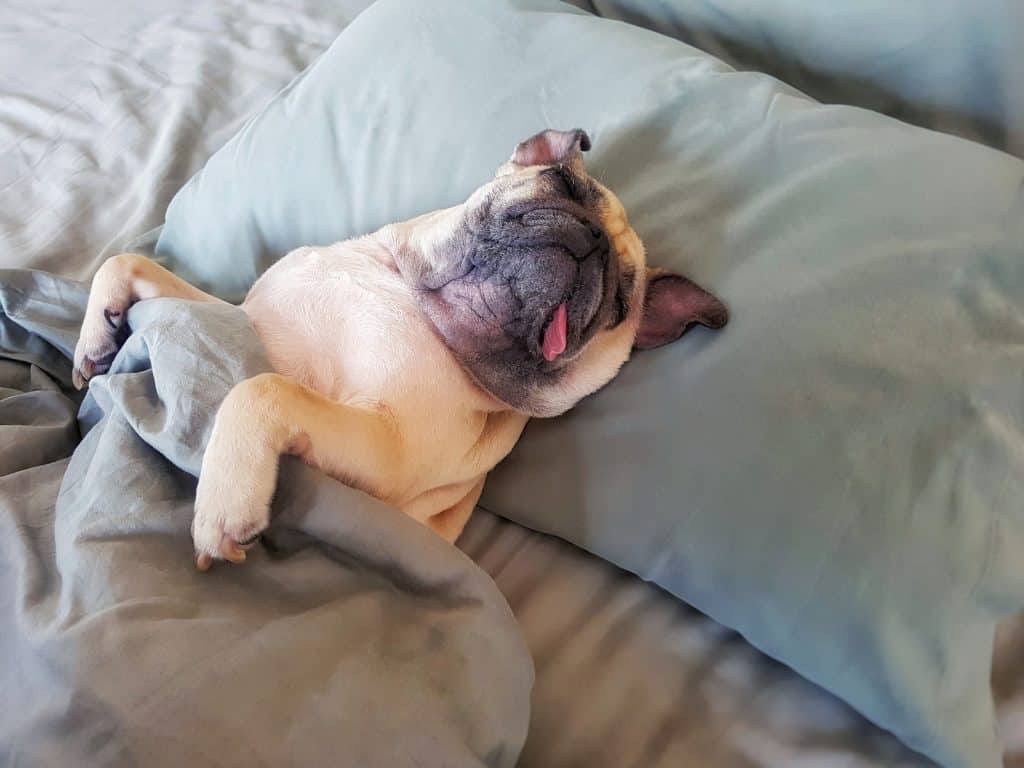
So, as you can probably tell, Pugs shed a lot. However, there are times when a Pug’s shedding becomes too much, which can often signify health issues.
Seeing as Pugs are prone to several serious conditions, it’s best to know the signs so you can catch them early.
The first important thing to know is the difference between normal shedding and a Pug losing hair in clumps.
While a shedding Pug will easily release large amounts of hair, these are generally different from clumps.
But how would you define a clump? Well, look for where the hair has come from. Is it from a normal shedding location or somewhere like the head or back?
Has all the hair come from the same place, and does it look more than usual? Most notably, hair that falls out in clumps won’t be replaced, so it will leave a bald spot.
One of the best advice I can give is to pay attention to your Pug’s normal shedding routine.
It won’t take long to pick this up, and after that you’ll be much more aware of any changes.
However, to give you some information, these are the main causes of excessive shedding.
- Stress
Yes, dogs can get stressed, and many things can cause it. These include moving house, separation anxiety, death of a pet or owner, and much more.
There are other behavioral symptoms of stress, so this shouldn’t be too hard to spot.
- Allergies
Pugs can develop a range of allergies, often resulting in skin irritation and hair loss. Typical allergens are found in food (such as wheat), medicine, environmental factors, shampoo, pest bites, and more.
If you’re concerned your dog is developing an allergy, visit the vet to be sure. The only real way to diagnose an allergy is a process of elimination, which can take a while. Therefore, it’s best to catch it early.
- Hormones
Pugs, like humans, can develop thyroid conditions. An underactive thyroid makes hair brittle, meaning it can snap easily and fall out much quicker.
Again, a vet can diagnose this, and treatment is very easy. So, like all other potentially dangerous conditions, be safe rather than sorry.
- Skin problems
Conditions such as ringworm and skin fold dermatitis[1] are common in Pugs, and they’re also prone to problems with mites.
These can lead to hair loss and baldness but are easily prevented with the correct medication and vaccines.
Once the skin condition has been treated, the Pug’s fur usually grows back.
Conclusion:
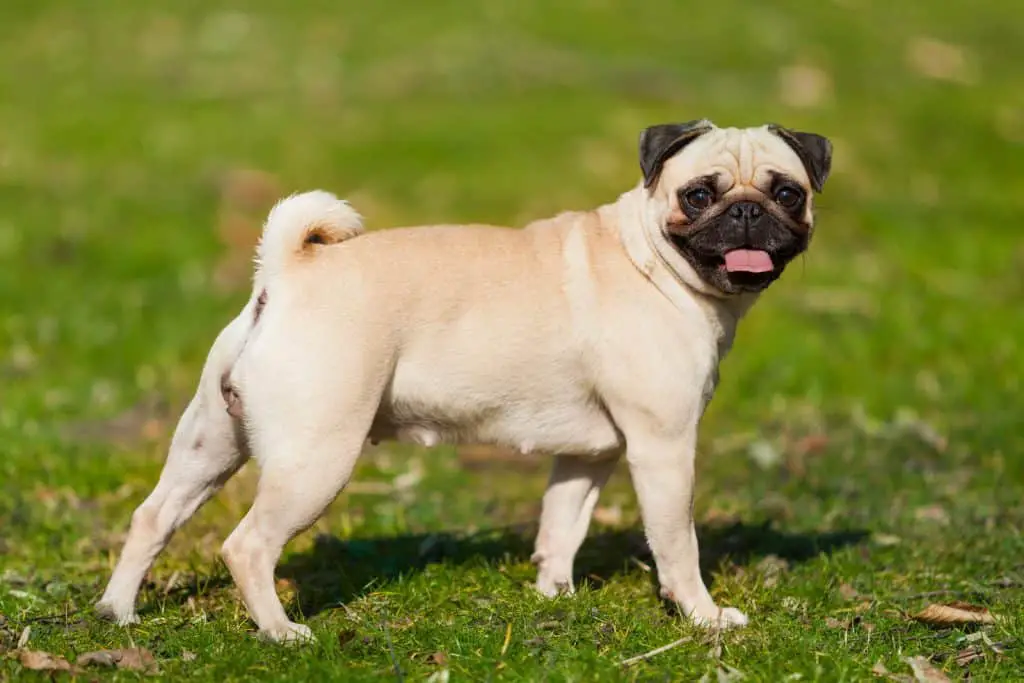
The main takeaway from this article is that Pugs are heavy shedders. While there are things you can do to manage the problem, there’s nothing you can do to prevent it.
Therefore, I feel it’s something potential Pug owners should consider as other pug pros and cons if they’re considering adopting a Pug.
If you like a clean house free of dog hair, please choose a different breed.
However, if this problem doesn’t bother you, you’ll have a friendly and affectionate breed joining your family!
My final advice is to be attentive to your Pug’s shedding habits.
This can help you tell the difference between normal shedding and illness, and catching conditions early enough gives you a much better chance of treating them.
REFERENCES:
1.[^]“Genetic Welfare Problems of Companion Animals.” UFAW, www.ufaw.org.uk/dogs/pug-skin-fold-dermatitis.

